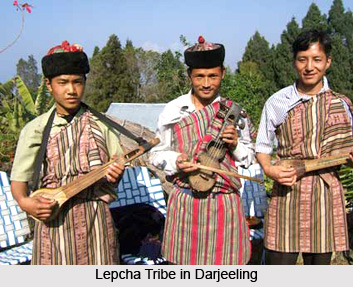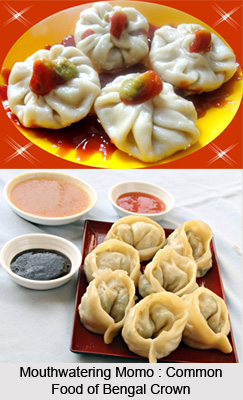 Culture of Darjeeling District is quite miscellaneous, due to the mixed ethnicity of the population. The local culture of Darjeeling can be well understood during the season of native festivals. The diverse community of people of Darjeeling District consists of the Lepchas (the original inhabitants), the diverse dialect groups of Nepali Gorkhas who form the majority, Bengalis, Tibetans, Biharis and Marwaris to name a few sects.
Culture of Darjeeling District is quite miscellaneous, due to the mixed ethnicity of the population. The local culture of Darjeeling can be well understood during the season of native festivals. The diverse community of people of Darjeeling District consists of the Lepchas (the original inhabitants), the diverse dialect groups of Nepali Gorkhas who form the majority, Bengalis, Tibetans, Biharis and Marwaris to name a few sects.
Lepchas were the original inhabitants of Darjeeling and Sikkim but they represent a minority of the population in today`s Darjeeling. Nepali Gorkhas constitute the majority of the population of Darjeeling today. They come from different castes and dialect groups like the Limbu, Gurung, Tamang, Rai, Newar, Mangar, Sherpa and Thami communities. The Tibetan community is comparatively a new addition to the population formed when thousands of Tibetan refugees settled across Darjeeling district in 1950 when China captured Tibet. The rest of the population is an assortment of people who are from the plains of India, from states like Orissa, West Bengal, Bihar, Assam and so on.
Festival contours the cultural synthesis of Darjeeling. Apart from the major Hindu religious festivals like Christmas, Diwali, Dussera, Holi, Ram Navami and others, the diverse ethnic population of the Darjeeling district observes several local festivals. The Tibeto-Burman ethnic groups like the Bhutias, Lepchas, Gurungs, and Tamangs celebrate New Year called Loshar during the months of January or February. Maghe Sankranti, Buddha Jayanti, Chotrul Duchen, and Tendong Lho Rumfaat are some of the local festivities in Darjeeling that largely tells about the culture of the place. Darjeeling Carnival, initiated by a civil society movement known as the Darjeeling Initiative, is a ten-day carnival held annually during winter that especially portrays the prosperous musical and cultural heritage of Darjeeling Hills as its basic theme.
 Food is an important element of the culture of Darjeeling. The most loved food in Darjeeling is the momo, a steamed dumpling containing mutton, pork, beef or vegetables cooked in a doughy wrapping served with a watery vegetable soup and spicy tomato sauce. Most of the food made in Darjeeling are dry in exteriors, like Wai-Wai is a favourite packaged snack of the hills comprising noodles which are eaten either dry or with soup. Churpee, a kind of hard cheese made from cow or yak`s milk happens to be another popular mini-snack that is truly nutritious. A form of noodle called thukpa, served with soup and vegetables, is extremely popular in the district. There are a number of restaurants offering a variety of traditional Indian, Continental and Indian Chinese cuisine to cater to the varied palette of the tourists. Tea is the most popular beverage, prepared from the famed Darjeeling tea gardens, as well as coffee. Chhang and tongba are local alcoholic beverages made from millet that is often especially ordered by the tourists.
Food is an important element of the culture of Darjeeling. The most loved food in Darjeeling is the momo, a steamed dumpling containing mutton, pork, beef or vegetables cooked in a doughy wrapping served with a watery vegetable soup and spicy tomato sauce. Most of the food made in Darjeeling are dry in exteriors, like Wai-Wai is a favourite packaged snack of the hills comprising noodles which are eaten either dry or with soup. Churpee, a kind of hard cheese made from cow or yak`s milk happens to be another popular mini-snack that is truly nutritious. A form of noodle called thukpa, served with soup and vegetables, is extremely popular in the district. There are a number of restaurants offering a variety of traditional Indian, Continental and Indian Chinese cuisine to cater to the varied palette of the tourists. Tea is the most popular beverage, prepared from the famed Darjeeling tea gardens, as well as coffee. Chhang and tongba are local alcoholic beverages made from millet that is often especially ordered by the tourists.
Culture of Darjeeling is also portrayed through its marvellous colonial architecture, characterising many buildings in Darjeeling; like the Gothic churches, Tudor residences, the Raj Bhawan (Governor House), Planters` Club and various educational institutions. Buddhist monasteries display the pagoda style architecture. Darjeeling is thought to be a center of music and a forte for musicians and music admirers. Singing and playing musical instruments is a common leisure among the resident population, who take pride in the traditions and role of music in cultural life. Western music is popular among the younger generation of Darjeeling, and it is a major center of Nepali rock music. Traditional dances in Darjeeling include the chutkay dance, jhaure dance, maruni dance and Tamang selos, which find their origins in Nepal. Other forms of dance in Darjeeling include the Tibetan Chaam performed with gaudy costumes and masks during the eve of Losar, the Tibetan New Year. Cricket and football are the most popular sports in Darjeeling. An improvised form of ball made of rubber garters is often used to play along the lonely steep streets.
Several monasteries like Ghum Monastery, Bhutia Busty monastery, Mag-Dhog Yolmowa are the preservation houses of ancient Buddhist scripts which still echo the culture of Darjeeling amidst their antiquity. Hinduism, Buddhism and to a certain extent Christianity are the chief religions practiced by people of Darjeeling. One can expect to find inter-faith places of worship like the Hindu temple at Dhirdham, Mahakal Temple, or the various Tibetan Buddhist monasteries like Yolmowa Buddhist Monastery or Aloobari Monastery, and the Dali Monastery. Nepali is the prime language used in Darjeeling with Hindi, English and Bengali being the other languages used for conversation between the locals and tourists.
The culture of Darjeeling has been retaining its charm and simplicity since ages. The hard line Indian politics has not yet made a strong hold in the region, thus enabling the inhabitants to spend a peaceful day and lulled to a quite night slumber.






